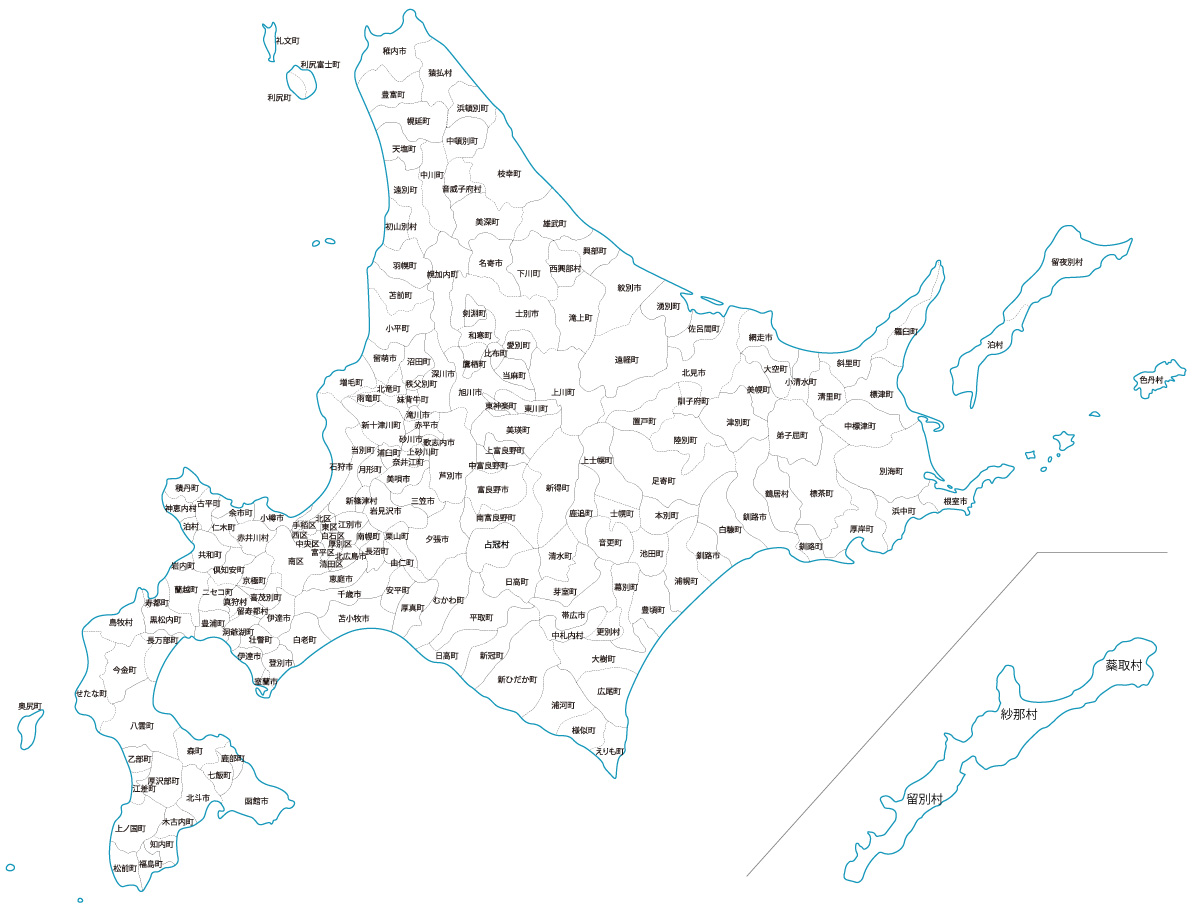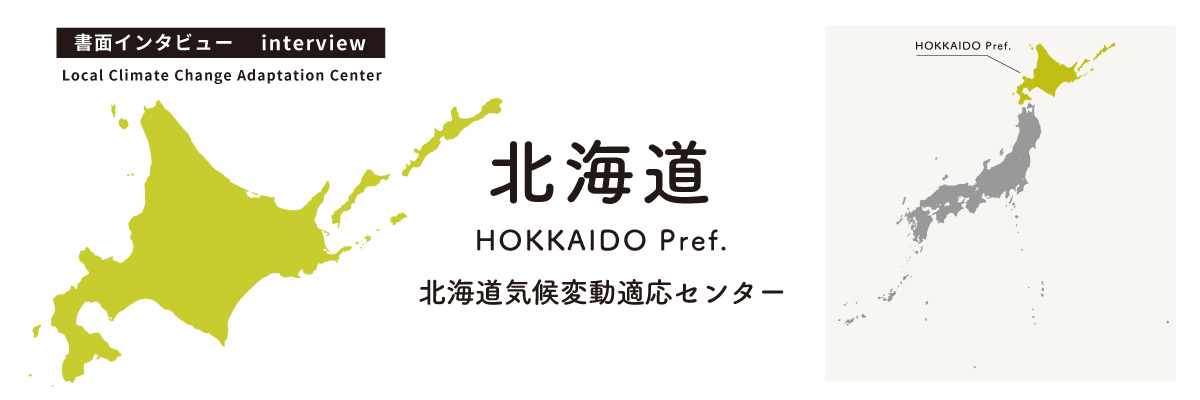Please tell us about Hokkaido Prefecture’s unique local features and characteristics, what led to the establishment of the Local Climate Change Adaptation Center, and what its organizational structure is like.
Located on the northernmost end of the Japanese Archipelago, Hokkaido has an area of 83,424 km2 (as of January 1, 2020), comprising roughly 22.1% of Japan’s territory. While about a half of the prefecture consists of mountainous areas, the ratio is actually lower compared to the rest of the country. So one topographic feature of Hokkaido is its many relatively flatlands with fewer mountains and slopes.
Hokkaido has unique terrain, cool weather, and three different oceans that surround it, which all support the prefecture’s agriculture, forestry, and fishery and provide high-quality food sources. Hokkaido is also an inviting island full of precious natural resources that cannot be experienced elsewhere in Japan, including the diverse species of fauna and flora that inhabit the prefecture’s natural parks, scenic views of cities and towns covered in snow during frigid winter, popular ski resorts offering great powder snow, drift ice that appears near the prefecture’s eastern coast, etc.
Meanwhile, the effects of climate change are also becoming more prominent in Hokkaido, manifesting, for example, as the series of typhoons that made landfall in the prefecture in August 2016, and the rainy season front that remained stationary over the region in July 2018, which caused significant damage to the prefectural residents’ living and industrial operations.
The Hokkaido Climate Change Adaptation Center was established in April 2021 to effectively deal with such impacts, gather, organize, analyze, and provide essential information conducive to the facilitation of climate change adaptation, and provide technical advice.
The Climate Change Adaptation Center is administered by the Hokkaido Prefectural Government (secretariat: Climate Change Policy Division, Bureau of Zero Carbon Promotion, Department of Environment and Lifestyle) and operated with the support of Hokkaido Research Organization (a local independent administrative agency; hereinafter referred to as the “HRO”), the Hokkaido Environment Foundation (a public interest incorporated foundation), and other concerned bodies.

Please tell us about the current activities of Hokkaido’s Local Climate Change Adaptation Center as well as its future plans.
As for our information gathering activity this fiscal year, we conducted a questionnaire survey of various municipalities across the prefecture to learn about the climate change impacts manifesting in their locales, the adaptation measures being implemented, their region-specific advantages and strengths, etc. All of the 14 Prefectural Promotion Bureaus along with municipality staff members agreed to participate in the survey, and we were able to obtain responses from all 179 municipalities. The survey revealed that, while 44% of the municipalities felt they were affected by climate change, as much as 65% of them were concerned about its future impacts, indicating that most of them were conscious of the toll that climate change will take on their communities (click here for survey reports).
In terms of our information provision activity, we have created a web portal dedicated to the topic of climate change adaptation, collected and posted scientific papers, sample case studies of businesses implementing adaptation measures, and other information relating to climate change impact and adaptation in Hokkaido, with the support of the HRO and universities based in the prefecture, and been issuing newsletters by email to municipalities and business operators (once a month).
As for technical consultation, we have been providing advice to various municipalities at climate adaptation seminars that are jointly organized with the Ministry of the Environment and on other occasions to assist with their local adaptation planning. Other activities include organization and transmission of information that might be useful to other departments of the prefectural government, research institutes, etc. with their action planning and research activities, and provision of information and insight to other prefectural departments, etc. concerning the correlation between climate change and the harmful algal bloom (red tide) that occurred along the prefecture’s Pacific coast in September and subsequent months last year, in coordination with the National Institute for Environmental Studies, etc.
Concerning our questionnaire surveys, we are intent on continuously conducting them in the next fiscal year onwards, switching targets each time, from specific types of businesses through agricultural and fisher cooperatives and other industrial associations, to prefectural residents, etc. to hear the voice of stakeholders in each category.
In addition, we are planning on using the findings from our surveys, etc. to further improve our information provision.
Please tell us about any unique approach that your Local Climate Change Adaptation Center is taking to effectively coordinate with other departments of the Hokkaido Prefectural Government and to facilitate adaptation by the prefecture and businesses, as well as any issues, etc. you are experiencing.
At the prefectural government, we have a suborganization called the Hokkaido Climate Change Action Facilitation Headquarters that is headed up by the Governor, under which various prefectural departments are coordinating with each other to facilitate climate change actions.
From this fiscal year, we have this revised organizational structure where different project teams (PTs) and working groups (WGs) below them are set up, under the umbrella of the aforementioned Headquarters, to deal with specific topics that require especially close coordination among different prefectural departments. Concerning climate change adaptation in particular, we have held reviews and discussions on how to develop a systematic procedure for integrating adaptation angles into the various action planning and research activities of different prefectural departments and also how we might be able to capitalize on climate change adaptation as an opportunity to promote businesses that are adaptive to changes in the earth’s weather.
In terms of any issues that require our addressing, we feel that our prefecture’s overall structure and resources being dedicated to the facilitation of climate change adaptation are still quite insufficient. According to our questionnaire survey conducted last July, only four out of all municipalities of the prefecture answered that they had created any adaptation plan, although most of them were apparently aware of climate change impacts, which led us to believe that there are various obstructive factors such as lack of human resource, other priorities, etc. that must be dealt with. To this end, our Center intends to play its part by providing support in the form of scientific knowledge, insight, and technical consultation to the municipalities in such a manner that is suitable for each locale with the aim of facilitating adaptation actions across Hokkaido.
Please tell us what motivates you to do your current work and also your outlook on the future.
In March 2020, Hokkaido announced its goal of achieving net-zero greenhouse gas emissions by 2050 to tackle the issue of climate change with a long-term perspective, along with its vision of “zero carbon Hokkaido” that involves full utilization of renewable energy as well as forests and other carbon absorbers, according to which activities are already underway to simultaneously achieve carbon neutrality, reenergize economic activities, and create sustainable local communities.
However, it is said that a certain level of temperature rise is unavoidable no matter how significant our collective mitigation actions may be, while the general consensus is that we must transform our society to carbon neutrality urgently. The expected effects of climate change that will likely manifest range from relatively obvious ones such as more reported cases of hyperthermia to more broad-ranged ones affecting different industries and involving various disaster risks, etc. Therefore, we firmly believe that our collective adaptation actions are of the utmost importance in order to avoid or mitigate these negative effects.
Our Center remains committed to utilizing all its available functions to integrate adaptation perspectives into the prefecture’s policy formulation and research activities and to providing information, public awareness and education programs, and technical consultation to various prefectural municipalities, business operators, and residents so that our stakeholders will find us increasingly reliable.
(Posted on March 31, 2022)


